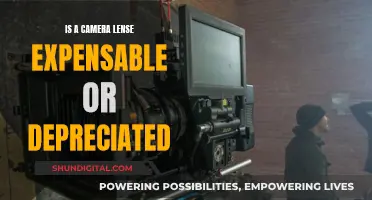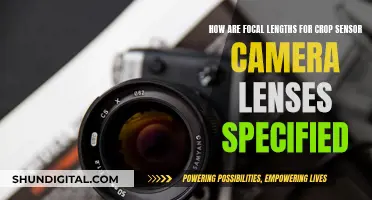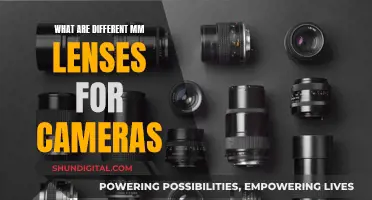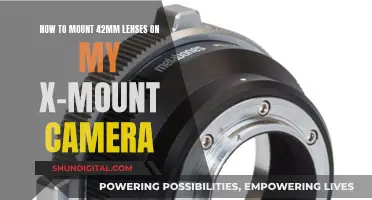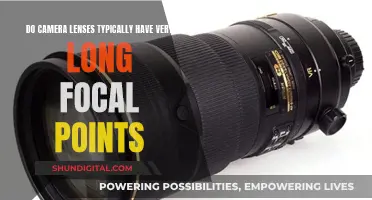
In the world of camera lenses, MD stands for Minolta MD. These are manual focus lenses that were released from 1977 onwards, with the older ones labelled MD Rokkor and the younger ones from 1981 simply labelled MD. Minolta MD lenses are not compatible with the Sony Alpha mount. However, they can be used with digital cameras with the right adapter.
| Characteristics | Values |
|---|---|
| Full Form | Minolta MD |
| Mount | Manuel focus Minoltas |
| Compatibility | Not compatible with Alpha |
| Diaphragm | Diaphragm lock button to access full range of f/stops |
| Mount Type | Last version of the Minolta manual mount |
| Adapter | Requires an adapter to be used on DSLRs |
What You'll Learn

MD stands for 'manual focus' Minolta lenses
MD stands for manual focus Minolta lenses. The mount was first called the SR mount, and when they added aperture priority it became the MC mount. Later, when they brought out more functions, they made some changes to the mount again and this was called the MD mount. No real definition was ever given for MD.
The Minolta SR mount was introduced in 1958 and succeeded by the incompatible A-mount in 1985. MD lenses (without the Rokkor designation) were introduced in 1981.
MD lenses can be used with great results on digital cameras, but an adapter is needed. The right adapter depends on the camera that will be used.
MD lenses are manual focus and are not compatible with AF or A-mount. They are also not compatible with a Sony Alpha mount.
Choosing Camera Lenses: A Guide to Shopping for Beginners
You may want to see also

MD lenses are not compatible with the Sony Alpha mount
MD stands for Minolta MD, which is the mount for manual focus Minolta lenses. These lenses are not compatible with the Sony Alpha mount. The Minolta MD mount was introduced in 1977, and the older MD lenses were labelled MD Rokkor, while the younger ones from 1981 onwards dropped the Rokkor and were simply labelled MD.
The Sony Alpha mount, also known as the A-mount, is incompatible with the Minolta MD mount. The A-mount was introduced in 1985, succeeding the Minolta SR-mount. While there are adapters available that can be used to attach Minolta MD lenses to Sony E-mount cameras, these adapters will not work with the Sony Alpha mount.
It is important to note that the Minolta/Sony Alpha mount is different from the Minolta manual focus mount, so Minolta MD lenses will not fit Sony Alpha cameras.
If you are looking to use Minolta MD lenses with a Sony camera, it is recommended to use a mirrorless camera such as the Sony A7 series or A6x00 series. These cameras have a shorter flange focal distance, making it easier to adapt Minolta MD lenses. However, keep in mind that you will lose autofocus, aperture control from the body, and EXIF information from the lens when using adapters.
Understanding Camera Lenses: Types and Their Uses
You may want to see also

MD lenses can be used on mirrorless cameras with an adapter
MD stands for Minolta manual focus lenses. They were introduced in 1977, and the older ones are labelled MD Rokkor, while the younger ones are just labelled MD. MD lenses can be used on mirrorless cameras with an adapter.
Mirrorless cameras have a much shorter flange focal distance, which is the distance from the lens mount to the camera sensor or film. This means that it is possible to adapt MD lenses to mirrorless cameras with a simple ring adapter. However, it is important to note that the crop factor of mirrorless cameras may cause some issues. MD lenses are manual focus and are unlikely to be wider than 28mm at affordable prices. When used on a mirrorless camera with a crop sensor, 28mm is not particularly wide anymore.
Additionally, mirrorless cameras tend to be small, and MD lenses can be large. Many mirrorless camera adapters prefer rangefinder glass, which can be more affordable and easier to find. When using an adapter with an MD lens on a mirrorless camera, you will lose autofocus, aperture control from the body, and EXIF information from the lens, as these lenses do not have electronic communication.
There are a variety of adapters available for MD lenses, ranging from budget options around $10 to premium options over $100. It is important to choose an adapter that fits both the camera and the lens. Some recommended adapter brands include K&F, Novoflex, Rayqual, Neewer, and Fotodiox.
When using an MD lens with an adapter on a mirrorless camera, the aperture is controlled manually by the user. This means that you will be shooting in full manual or aperture priority modes. It is also worth noting that some mirrorless cameras, such as those from Sony, may require specific adapters to work with MD lenses.
In summary, MD lenses can be adapted to mirrorless cameras with the right adapter, but there may be some limitations in terms of autofocus, aperture control, and EXIF information. It is important to choose a quality adapter that fits both the camera and the lens to ensure the best results.
Q-See Camera Lenses: Plastic or Glass?
You may want to see also

MD lenses were introduced in 1977
The MD mount featured an additional lever that allowed the reporting of the lens being set to its smallest available aperture. This was used by the camera to accomplish shutter priority automatic exposure in S mode on the Minolta XD-7 (XD-11 in the USA), and later in the P (programmed automatic exposure) mode on the X-700. The MD mount was also known as the MD bayonet.
MD lenses were labelled MD Rokkor or MD. The older MD lenses were labelled MD Rokkor, but from 1981 onwards, the 'Rokkor' was dropped and the lenses were simply labelled MD.
The MD mount was forwardly inclusive and backwardly compatible with the previous SR and MC mounts.
Bigger Camera Lenses: Do They Make a Difference?
You may want to see also

MD lenses are labelled 'MD Rokkor'
MD lenses are labelled MD Rokkor because Rokkor was a brand name used for Chiyoda Kōgaku Seikō and later Minolta lenses between 1940 and 1980. The name was derived from the name of Rokkō, a 932-metre-high mountain, which could be seen from the company's glass-making and optics factory at Mukogawa near Osaka, Japan. The company's founder, Kazuo Tashima, wanted the name to symbolise high-quality optics.
The first lens to carry the Rokkor designation was a 200mm f/4.5 lens that came with the hand-holdable aerial camera Chiyoda SK-100 in 1940. After the Rokkor name was dropped and no longer engraved on new lenses after 1980/1981, the name resurfaced twice. Firstly, as revealed in 2006, the Rokkor name was still used internally for prototypes of a never-released SR-mount Minolta MD Apo Tele Rokkor 300mm f/2.8 manual-focus lens in the early 1980s. Secondly, the Rokkor name was also resurrected for a short time between 1996 and 1998 for the Minolta G-Rokkor 28mm f/3.5 lens.
The Minolta SR-mount was the bayonet mounting system used in all 35mm SLR cameras made by Minolta with interchangeable manual focusing lenses. The mount itself was sometimes referred to by the name of the corresponding lens generation, for example, "MC" or "MD". MD lenses are labelled MD Rokkor or MD.
The MD designation refers to an additional tab on the lens, introduced in 1977, which reported the smallest available aperture (f/16, f/22, or f/32) to the camera to accomplish shutter priority automatic exposure in S mode on the Minolta XD-7 (XD-11 in the USA), and later in the P (programmed automatic exposure) mode on the X-700. The proper use of this feature meant that the lenses had to be set to their smallest aperture. In 1981, MD lenses included a minimum aperture lock that prevented the aperture ring from being moved accidentally.
Camera Lenses: Tangible Personal Property or Not?
You may want to see also
Frequently asked questions
MD stands for Minolta MD, which is the mount for manual focus Minoltas.
MC lenses were released between 1966 and 1977 and are labelled MC Rokkor. MD lenses were released from 1977 onwards and are labelled MD Rokkor, although newer ones from 1981 onwards are just labelled MD.
Yes, you can use Minolta MD lenses on digital cameras with the right adapter.
Minolta introduced the SR-mount in 1958 and it was succeeded by the incompatible A-mount in 1985.
No, the MD lenses are not compatible with the A-mount.


